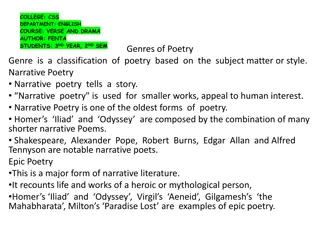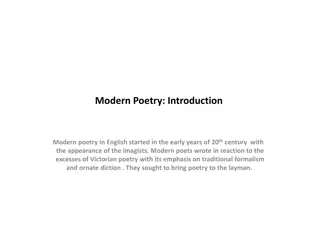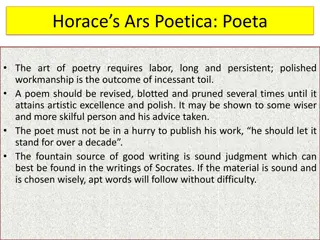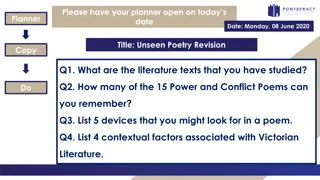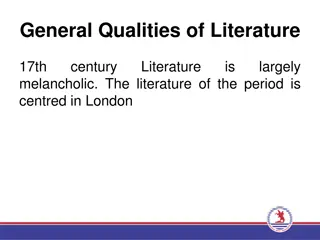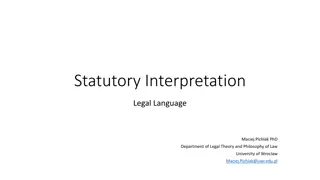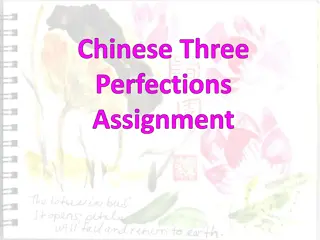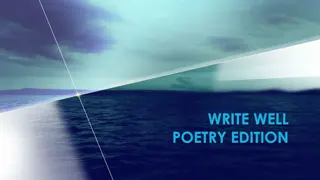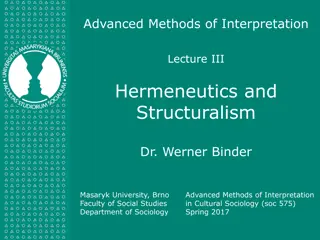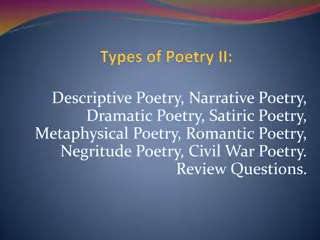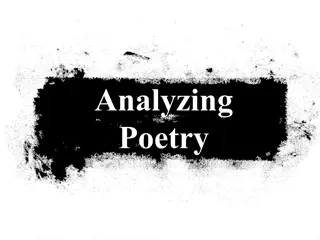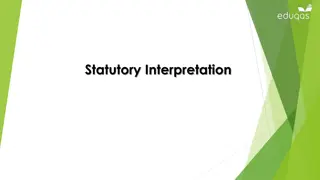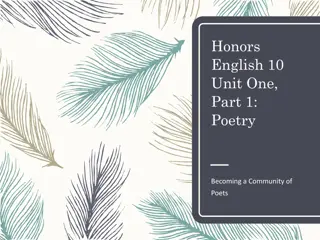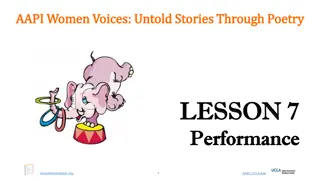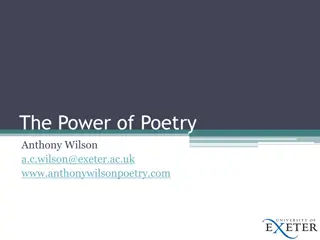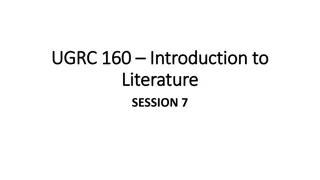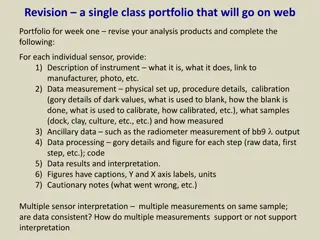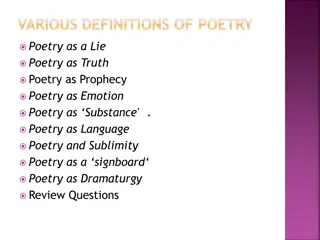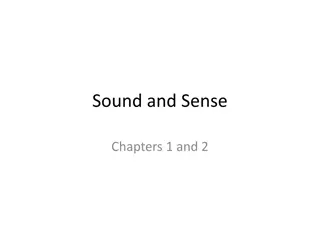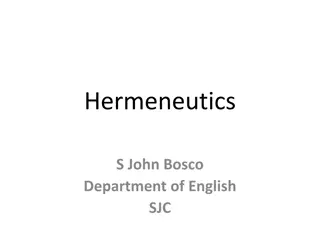Poetry: Analysis and Interpretation
Dive into the depths of poetry by exploring themes, speaker characteristics, emotions, setting, and poetic devices. Uncover the hidden meanings, tones, and atmospheres within the verses to grasp the full essence of the poems by Hardy and Housman.
Download Presentation

Please find below an Image/Link to download the presentation.
The content on the website is provided AS IS for your information and personal use only. It may not be sold, licensed, or shared on other websites without obtaining consent from the author.If you encounter any issues during the download, it is possible that the publisher has removed the file from their server.
You are allowed to download the files provided on this website for personal or commercial use, subject to the condition that they are used lawfully. All files are the property of their respective owners.
The content on the website is provided AS IS for your information and personal use only. It may not be sold, licensed, or shared on other websites without obtaining consent from the author.
E N D
Presentation Transcript
Basic Poetry Analysis Hardy and Housman
Poetry: Content/Subject and Theme(s) Does the title give you an idea of what the poem may be about? What is the poem about? What concept and ideas is the poem exploring? What is the writer s view on this subject? Are there messages or ideas that are repeatedly stated in the poem to draw the reader s attention? Are the themes and messages implicitly or explicitly stated in the poem? How are the ideas organized: are they developed in a straightforward manner to a conclusion? Is there a shift or turning point in its development?
Poetry: Speaker, Tone and Voice Who is the speaker of the poem? Is the speaker the poet or a character/persona the poet takes on? Who is the speaker speaking to? What is the tone of voice adopted? What is the speaker s attitude towards the subject in the poem? Does the poem sound happy or sad when you read it aloud? What other words come to mind?
Poetry: Feelings and Emotions Positive Negative Others Appreciative Aggressive Apologetic Calm Angry Bold Cheerful Annoyed/irritated Cautious Comforting Anxious/agitated Firm Content Apprehensive Ironic Devoted Bitter Mysterious Delightful Confused Nostalgic Enthusiastic Cruel/harsh/hurtful Regretful/remorseful Joyful Depressed/melancholic Religious/spiritual Optimistic Disappointed Sarcastic Passionate Indifferent/apathetic Secretive Sincere Lonely Sentimental Troubled
Poetry: Setting and Atmosphere Where and when is the poem set? Does the setting create any prevailing feeling in the poem? Does the setting affect the mood of the speaker? How would you describe the mood and atmosphere?
Poetry: Poetic Devices Does the poet use imagery in the poem? What senses (i.e. sight, hearing, smell, taste, touch) are appealed to? Does the poet use poetic techniques such as similes, metaphors, personification, metonymy or other figurative language such as symbolism in the poem? What effects do the devices create and how do they help to present the themes of the poem?
Poetry: Diction/Word Choice/Use of language How would you characterize the language and diction in the poem? Is there a tendency to use a particular kind of language (e.g. colloquial/formal/slangy/archaic expressions, foreign terms or indigenized varieties of English)? Is there any unusual use of language (e.g. inverted order of words, coined words) that breaks the conventions and rules? Are there any lines or words that stand out in the poem (e.g. repeatedly used or inconsistent with the rest of the poem)? Is there any significance to the capitalization and spelling of words? What effects does the choice of language create? How would you describe the language?
How we talk about poetry: Setting and atmosphere Where and when is the poem set? What mood and atmosphere does the setting create? Let s read The Darkling Thrush and consider some answers to this question. Remember to provide specific textual examples.
One possible response to The Darkling Thrush The poem The Darkling Thrush is set at in the twilight on the last day of the nineteenth century. The speaker is leaning on a wooden gate looking at the darkening countryside. The setting creates a bleak, gloomy and depressing mood, making the speaker fervourless . The poet compares the setting sun to a weakening eye as night falls and he describes a desolate scene with frost taking over the land like a corpse and stems of trees standing like strings of broken lyres (harps) . The time setting of the poem imparts a sense of loss and sorrow as the day, year and century are ending at once and it seems to suggest also the end of life and the world. The desolate winter landscape with no life growing, only the frost shrouding the ground and the wind making funeral music in the trees, is also eerie, spooky and ghostly. Both the time and place convey a sense of hopelessness and lifelessness.
How we talk about poetry: Poetic Devices Comment on the poetic devices used in the first two stanzas of in Thomas Hardy s The Darkling Thrush and discuss the effects they create Remember to provide specific textual references.
Another possible response to The Darkling Thrush In The Darkling Thrush , imagery and comparison (i.e. similes and metaphors) are extensively used to build the desolate setting and depressing mood. In Stanza 1, the frost is compared to a grey ghost at dusk that shrouds the land, which creates a ghostly winter scene associated with death. The setting sun is described as a weakening eye and the metaphor of dregs is used to suggest the fading light of dusk. A simile is used when the poet likens the leafless stems and bare trunks to a 12 broken lyre/harp, showing the barrenness and inability to produce life and music. In Stanza 2, metaphors are used to compare the landscape to a corpse and the darkening sky to a tomb, which further accentuates the spooky mood. The rich visual, auditory and tactile imagery in the poem appeals to readers sense of sight, hearing and touch, creating a vivid picture of the haunted countryside in a darkening dusk, which helps to present the theme of death and ending.
How we talk about poetry: Diction/Word choice/Language Comment on diction of Thomas Hardy s The Darkling Thrush and discuss the effects the use of language creates. Remember to provide specific textual references.
Yet another possible response to The Darkling Thrush In The Darkling Thrush , archaic language (e.g. coppice [group of trees], spectre [ghost], darkling [in the dark], lyre [harp], crypt [tomb], illimited [free from limitations], nigh [near]) and some unusual combinations of words (e.g. death-lament and outleant ) can be identified in various places. The use of archaism reflects the poet s Keatsian lyrical style and the Romantic literary tradition. In addition to the use of archaism, the poet uses a lot of single adjectives before nouns. A lot of negative adjectives (e.g. desolate, weakening, tangled, broken, haunted, cloudy, shrunken, hard, dry and fervourless) are used in Stanzas 1 and 2 to express the dark feelings and dejected mood of the speaker. In contrast, positive adjectives (e.g. full-hearted, illimited, growing, ecstatic, happy, blessed) and feelings words (e.g. joy, Hope) are used in Stanzas 3 and 4 to show the uplifted spirit of the speaker after listening to the joyful singing of the aged thrush. It is also worth noting that words with religious meanings (e.g. evensong, soul, carolings, blessed) are often used in the description of the bird. This religious association is accentuated with the capitalization of the word Hope towards the end of the poem. The thrush seems to symbolize a spiritual force in nature and represent a harbinger of hope.





